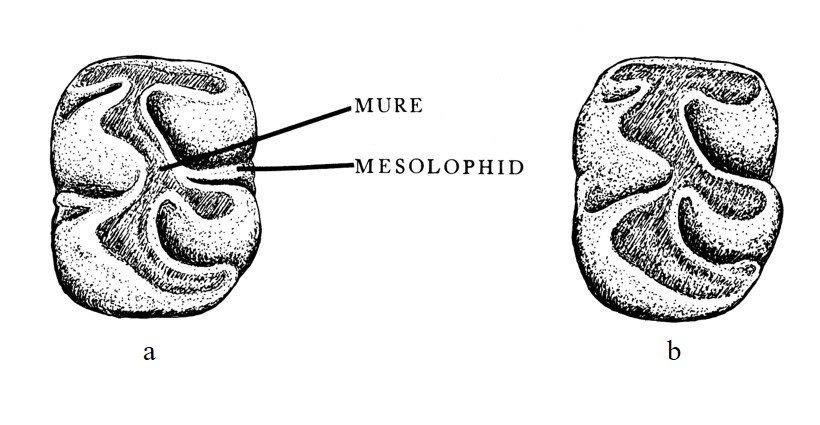TEXAS DEERMOUSE
Peromyscus attwateri J. A. Allen 1895
Order Rodentia : Family Cricetidae
DESCRIPTION. A medium-sized Peromyscus with the tail about as long as (or slightly longer than) the head and body, moderately haired, darker above than below (but not sharply bicolor) and usually with a terminal tuft; hind foot large (24–27 mm); ankles usually dark or dusky; dorsal color near sayal brown, darker and mixed with blackish along midline; sides pinkish cinnamon; ventral color pure white, the bases of the hairs plumbeous; length of maxillary tooth row ≥4 mm; each large upper and lower molar has an accessory loph (see figure below). Dental formula: I 1/1, C 0/0, Pm 0/0, M 3/3 × 2 = 16. Averages for external measurements: total length, 198 mm; tail, 103 mm; hind foot, 25 mm. Weight of adults, 25–35 g.


DISTRIBUTION. Common in central part of state (Edwards Plateau) southward to Uvalde, Medina, and Bexar counties and westward to Randall, Lynn, and Ward counties. It is commonly referred to as the Texas deermouse, although its distribution also includes Oklahoma, Kansas, Missouri, and Arkansas.

SUBSPECIES. Monotypic species.
HABITS.Peromyscus attwateri inhabits the cliffs and rocky outcrops of the Edwards Plateau, the west Cross Timbers, the Rolling Plains, and the escarpment of the Llano Estacado in Texas. Vernon Bailey recorded that in the vicinity of Kerrville he caught many of them in traps set in crevices along the cliffs, under logs in the woods, and under fallen grass and weeds on a creek bank in the bottom of a gulch, as well as under heaps of driftwood. They seem to prefer rocky areas on the Edwards Plateau where the dominant vegetation is juniper. They are adept at climbing. In 1961, Charles Long (University of Kansas) recorded that P. attwateri, compared with other species of Peromyscus, is a superior and more cautious climber, seldom jumps from high places when under stress, and is more capable of finding its way in darkness. Recent studies using tagged P. attwateri have shown that this deermouse, at least in some areas, is semiarboreal and travels frequently in trees. Where P. attwateri and P. laceianus (formerly P. pectoralis), coexist, P. laceianus specializes in areas of rock ledges and leaf litter, whereas P. attwateri is more of a habitat generalist and may be found not only in areas of rock ledges and leaf litter but also in more open, grassy areas with only scattered rock cover. Where the two species were sympatric, in Tom Green County, P. attwateri utilized trees for refuge and escape cover more often than P. laceianus.
The Texas deermouse occurs along the escarpment of the Llano Estacado from Armstrong County southward to Martin County, inhabiting rocky, gravelly areas that are vegetated with Juniperus spp., Rhus trilobata, Quercus spp., and various grasses and forbs. At Palo Duro Canyon, it occurs with P. truei, but there seems to be some microhabitat separation between the two species, with truei occupying the more precipitous rocky areas on the escarpment.
Seeds and insects make up the bulk of its diet. Peromyscus attwateri readily feeds on grasshoppers, crickets, and other arthropods. Other diet items include juniper berries, green vegetation, acorns, and plant bulbs. This mouse is highly arboreal and may forage for berries and nuts in trees. It is nocturnal in its foraging and activity period.
In a 1967 ecological study of this mouse in Lynn County, Herschel Garner found that reproductive activity began in late September and continued throughout the winter. He found no evidence of their breeding during late spring and summer. The number of young per litter varies from one to six and averages about four. In 1964, based on data derived from the retrapping of marked animals, Larry Brown estimated the average life span to be 6.8 months, with a maximum of 18 months.
POPULATION STATUS. Common. The Texas deermouse is common throughout its range in Texas and has fared well with the massive expansion of brush species, especially cedar, in the state.
CONSERVATION STATUS. The IUCN lists Texas deermouse as a species of least concern, and it does not appear on the federal or state lists of concerned species. There are no immediate threats to its conservation status.
REMARKS.Peromyscus attwateri was formerly treated as a subspecies of P. boylii until DJS removed attwateri and returned it to its original status as a full species. This taxonomic change was based primarily on characteristics of the karyotype (attwateri has six large biarmed autosomal chromosomes; boylii from West Texas has only two). In addition to chromosomal differences, the most useful morphological features available in the field, and to those not trained in cytogenetics, are the larger hind foot (24–27 mm in attwateri and 20–23 mm in Texas-taken boylii) and the structure of the molar teeth. In attwateri, an accessory loph is present in both the upper and lower molars, but that structure is absent from the lower molars of boylii (see figure above).
Peromyscus attwateri can be distinguished from P. truei by its longer hind foot (>23 mm rather than <23 mm) and shorter ears (<21 mm rather than >22 mm).
From The Mammals of Texas, Seventh Edition by David J. Schmidly and Robert D. Bradley, copyright © 1994, 2004, 2016. Courtesy of the University of Texas Press.
Natural Science Research Laboratory
-
Address
Museum of Texas Tech University, 3301 4th street, Lubbock, TX 79409 -
Phone
806.742.2486 -
Email
nsrl.museum@ttu.edu

